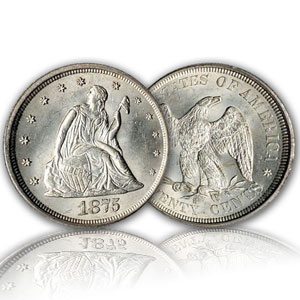The American twenty-cent piece was a coin struck from 1875 to 1878, but only for collectors in the final two years. Proposed by Nevada Senator John P. Jones, it proved a failure due to confusion with the quarter, with which it was close in size. In 1874, the newly elected Senator Jones began pressing for a twenty-cent piece, which he stated would alleviate the shortage of small change in the Far West. The bill passed Congress, and Mint Director Henry Linderman ordered pattern coins struck. Linderman eventually decided on an obverse similar to that of other silver coins. Although the coins had a smooth edge, rather than reeded as with other silver coins, the new piece was close to the size of, and immediately confused with, the quarter. Adding to the bewilderment, the obverse, or "heads", sides of both coins were almost identical. After the first year, in which over a million were minted, there was little demand, and the denomination was abolished in 1878.

A twenty-cent piece had been proposed as early as 1791, and again in 1806, but had been rejected. The 1806 bill, introduced by Connecticut Senator Uriah Tracy, sought both a two-cent piece and a "double dime". It was opposed by Mint Director Robert Patterson, though his opposition was more to the two-cent piece, which Tracy proposed be struck in billon, low-grade silver that would be difficult to recover when melting the coins. The bill passed the Senate twice, in 1806 and 1807, but did not pass the House of Representatives.
Several factors converged to make possible a twenty-cent piece in the 1870s. The first was a shortage of small change in the Far West, where base-metal coins did not circulate. Government payments in silver or gold had been suspended during the economic chaos caused by the Civil War—coins containing precious metal were hoarded except on the Pacific Coast, and did not pass at face value in trade. Although the base-metal nickel was not widely accepted in the Far West, the silver half dime had been struck in increasing numbers at the San Francisco Mint until the silver coin, which did not circulate in the East, was abolished by Congress in 1873. A shortage of small change resulted, especially as half dimes were used in the jewelry trade; customers complained they could not get full change for an item costing ten cents for which they paid with a quarter. Prices in the West were sometimes in bits (121⁄2 cents, based on the old Spanish colonial real, although those pieces no longer circulated), adding to the change problem. Numismatist David Lange states that a shipment of nickels out West could have solved everything, but that they might not have been accepted due to the prejudice against money which did not contain precious metal.
A second factor was the anxiety of Congress to see more silver made into coin. This was due to pressure from mining and other interests. The Coinage Act of 1873 ended the practice of allowing silver producers to have their bullion struck into silver dollars and returned to them. Although producers had not deposited much silver in the years before 1873 due to high market prices, Director of the Mint Henry Linderman foresaw that those prices would fall as mines became accessible due to the completion of the transcontinental railroad across the United States, and that the resultant coinage would inflate the currency. He quietly urged Congress to end the practice, which it did. Within a year, silver prices had dropped, and producers tried vainly to deposit bullion at the mints for conversion into legal tender. Mining interests sought other means of selling silver to the government.
The third was American interest in aligning its currency with the Latin Monetary Union and to bring its weights for coinage into the metric system. Several times in the 1860s and 1870s, the Bureau of the Mint struck pattern coins that might be used if America joined, in some cases with the equivalent in foreign money struck as part of the design. The twenty-cent piece would be equivalent to one French franc in that system, and if in proportion to the smaller silver coins being struck, would weigh five grams, a fact which appealed to advocates of the metric system in Congress. Another purpose for a large issue of silver coins, regardless of denomination, was to retire the Fractional currency—low-value paper money or "shinplasters". Congress passed legislation in 1875 and 1876 for large quantities of silver coins for this purpose.
The father of the twenty-cent piece was Nevada Senator John P. Jones. Part-owner of the Crown Point Mine, he had been elected to the Senate in 1873; on February 10, 1874, he introduced a bill to authorize a twenty-cent piece, one of his first legislative endeavors. In advocating for the proposal, he cited the lack of small change in the West. It was endorsed by Mint Director Linderman; according to numismatic historian Walter Breen, "other legislators went along with it, largely as a favor to Sen. Jones". The bill was signed into law by President Ulysses S. Grant on March 3, 1875. Like other denominations of silver coin, the twenty-cent piece was made legal tender up to five dollars.